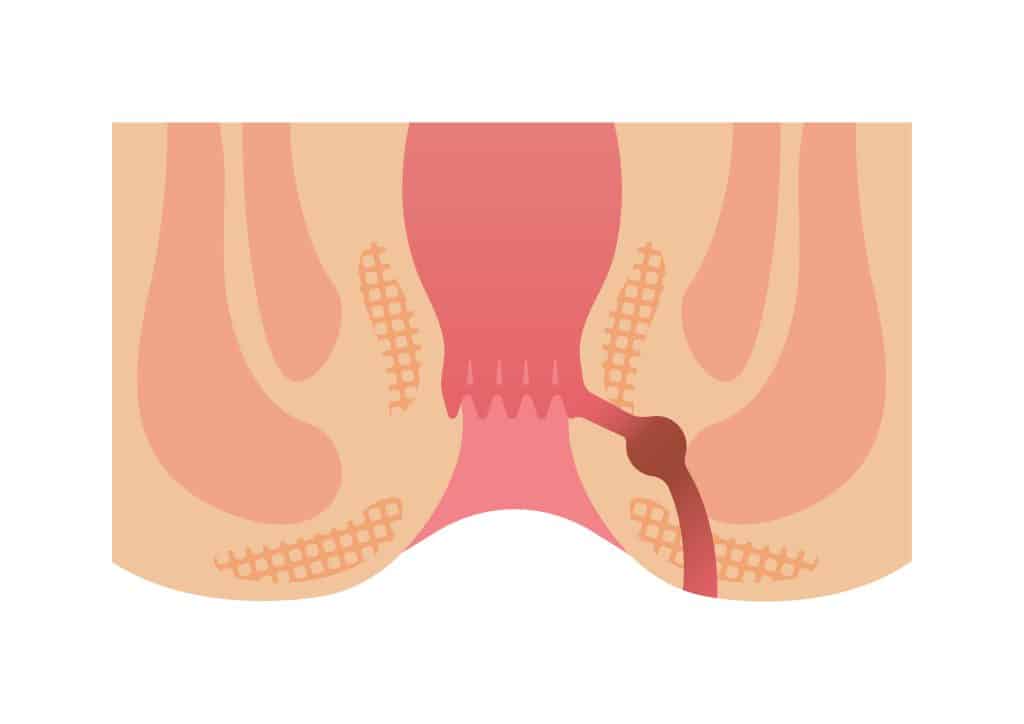An anal fissure and hemorrhoids are common conditions that affect the anal area and are often confused with each other due to similar symptoms. While both conditions can cause pain, bleeding during bowel movements, and discomfort, hemorrhoids and an anal fissure are completely different.
The biggest difference in symptoms is that hemorrhoids cause a pressure, pulsating or aching pain and an anal fissure, which is a cut of the anal skin, causes a sharp, tearing or cutting pain. Understanding the difference between an anal fissure vs hemorrhoids can help you manage your symptoms and improve your overall anal health.
What are Hemorrhoids?

Before learning the differences between an anal fissure vs hemorrhoids , it’s important to know what each condition is and the symptoms.
Hemorrhoids are veins which reside inside and outside of the anus. They are organs just like lungs, heart, kidneys and spleen are organs. Hemorrhoids are venous cushions which have a blood supply (artery which pumps blood into the hemorrhoid) and a venous return (veins which return the blood to the body). They are a part of our anatomy just like our eyes, nose, ears, toes, etc.
We are born with at least 6 hemorrhoids, three within the anus (internal hemorrhoids) and three outside the anal opening (external hemorrhoids). Though we have theories as to the function of hemorrhoids, there is no real scientific evidence of their purpose. It is proposed that the function of hemorrhoids is to aid in keeping stool from leaking out of the anus.
When hemorrhoid veins become inflamed and enlarged they can become symptomatic. The blood pumped into the hemorrhoid is thin and normal, but when the blood enters the inflamed hemorrhoid the inflammatory proteins made by the body thicken the blood so it is difficult to leave the hemorrhoid. This is called chronic venous insufficiency (CVI). With CVI there is more blood leading into the hemorrhoid than returning to the body. Think of a water balloon on a faucet but the balloon has tubes allowing water to flow back to the system. If the water coming into the balloon becomes thick like maple syrup, more water will enter the balloon than will leave the balloon so the balloon becomes bigger. As hemorrhoids become larger they start to cause symptoms.
There are several reasons why hemorrhoid symptoms develop, such as:
- Straining during bowel movements due to constipation
- Urgency to have a bowel movement – diarrhea
- Sitting for long periods of time
- Obesity
- Pregnancy
- Aging
- Chronic bowel issues
- A family history of hemorrhoids.
Symptoms of hemorrhoids:
The symptoms of hemorrhoids include internal hemorrhoid symptoms and external hemorrhoid symptoms. Though patients may experience pain, this pain is a throbbing, aching, toothache type pain, which is different from a fissure pain that tends to be sharp.
Internal hemorrhoid symptoms:
- Throbbing, aching pain around the anus
- Itching
- Painless bleeding
- Anorectal pressure
- Prolapse, a protrusion outside of the anus
- Urgency or the feeling of having to have a bowel movement but no stool comes out
- Mucous discharge
- Necrosis; when the hemorrhoids become trapped outside the anus and the hemorrhoid tissue starts to die). This is a surgical emergency.
External hemorrhoid symptoms:
- Thrombosis; a clot within the hemorrhoid, which causes pain, itching and sometimes bleeding with clots, if the hemorrhoid ruptures. A painful swollen lump that looks like a purple grape is a thrombosed hemorrhoid. 95% of the time thrombosed hemorrhoids will resolve on their own and recurrence in the same spot is unlikely therefore only conservative therapy is needed.
- Necrosis; when the external hemorrhoid becomes thrombotic and due to the pressure in the hemorrhoid the tissue starts to die. This is a surgical emergency.
- Swelling without clotting
What is an Anal Fissure?

An anal fissure is a small tear in the skin at the edge of the anus. A fissure causes a sharp pain, and bleeding during or after a bowel movement. The pain can last for seconds, minutes, hours or all day. A fissure can happen at any age, but is common in older adults, young children, and infants.
The most common reason an anal fissure occurs is due to trauma in the anal canal, such as passing hard stools from constipation or diarrhea. Other reasons why an anal fissure may develop are childbirth, anal sex, hemorrhoid excision and Crohn’s disease.
Symptoms of an Anal Fissure
Symptoms of an anal fissure are similar to hemorrhoids and can often be confused with the condition.
- Sharp pain or discomfort at the anus with or after a bowel movement
- Burning around the anus after a bowel movement
- Sharp painful anal lump. The lump is the swollen skin around the cut. This is what confuses patients because when we look up a painful, bleeding anal lump the vast majority of headings only discuss hemorrhoids.
- Anal itching
- Blood in the bowel or on toilet paper during or after defecation
What are the Treatment Differences: An Anal Fissure vs Hemorrhoids?
Although an anal fissure and hemorrhoids have common symptoms, the two entities are vastly different and are treated differently with some overlap in conservative therapy. However, the surgery to treat an anal fissure is completely different from the surgery for hemorrhoids.
Anal fissure and hemorrhoid therapies:
- PERFECT P.O.O.P. which is an all natural, non medicinal VEGAN fiber to help bulk the stool.
- Sitz baths
Anal anal fissure therapies:
- A topical sphincter muscle relaxing ointment
- Nitroglycerine 0.2%
- Nifedipine 0.2%
- Diltiazem 2%
- Application of Silver Nitrate – This therapy is done in the office. Silver nitrate which is a caustic agent burns the fissure. The premise is that a non healing anal fissure has poor scar tissue which won’t heal. By using a chemical to burn the wound new scar tissue will form. The benefits of silver nitrate is that it can be done in the office, it’s very effective, and you avoid surgery. The downside to the procedure is that recurrences are high because it is not treating the cause of the fissure which is the tight anal sphincter. Silver nitrate can also burn other parts of the anal skin, if not treated carefully.
Internal hemorrhoid therapies:
- Hemorrhoid sclerotherapy done in the office
- Hemorrhoid banding done in the office
- Hemorrhoid infrared coagulation done in the office
- Steroid suppositories
External hemorrhoid therapies
- Steroid ointments
- Vaseline
- Recticare (Lidocaine ointment to help alleviate the pain)
- Internal hemorrhoid sclerotherapy done in the office to help indirectly shrink the external hemorrhoid.
Surgery Treatments
Anal fissure surgery
- A fissurectomy, which removes the fissure, and a partial lateral internal sphincterotomy or partial cut of the internal sphincter muscle. Best and most effective surgery.
- Fissure debridement and injection of Kenalog (steroid). It is a newer surgery and results vary.
Internal hemorrhoid surgery
- Surgical removal of the internal and external hemorrhoids for large internal hemorrhoids in which conservative therapy has failed. Most reliable surgery with fewest recurrences.
- Doppler surgery – THD or DGHAL – Non cutting surgery for internal hemorrhoids. I used to do this but abandoned the procedure as I felt there were too many recurrences.
- Procedure for Prolapse and Hemorrhoids (PPH) – Lifts the hemorrhoids using a special stapler which cuts a sleeve of tissue and staples it back together. This lifts the internal hemorrhoids. I stopped doing this as I felt there were too many recurrences and some of the risks were serious.
- Laser hemorrhoid surgery – This procedure surgically removes the internal and external hemorrhoids with cutting. The laser is the instrument which cuts the tissue. It is touted as painless, however; good studies show it is a very painful procedure and more painful than cutting with a scalpel. In my experience I agree with this. I do not perform laser hemorrhoid surgery.
Your proctologist will be able to recommend the best course of treatment, as well as determine the severity of your condition.
Other Conditions Similar to an Anal Fissure and Hemorrhoids

When it comes to an anal fissure vs hemorrhoids, both conditions have similar symptoms and both can be treated conservatively. If you are experiencing symptoms similar to hemorrhoids or anal fissure, it’s important to see a proctologist. There are several other conditions that can cause the same symptoms as hemorrhoids or an anal fissure, including serious ones.
Rectal prolapse – This occurs when the rectum protrudes through the anus which can cause discomfort, pain and bleeding during bowel movements.
Anal abscess – With an abscess, a collection of pus gathers in the anal area which causes pain, fever, and swelling.
Anal fistula – A fistula is a small tunnel that forms between the anus and the skin around it. Anal fistulas can cause pain, swelling and discharge of pus or blood.
Inflammatory bowel disease – An umbrella term: IBD can include conditions such as Cronh’s disease and Ulcerative Colitis. Crohn’s disease can cause deep anal fissures, abscesses and fistulas which have similar symptoms to hemorrhoids and an anal fissure.
Proctitis – An inflammation of the rectum. Symptoms include pain, bleeding, and discharge from the anus.
Anal cancer – Cancer that develops in or outside the anus. As the cancer grows it becomes an uncomfortable anal lump. Due to the lack of pain many patients do not seek therapy as they feel it is just a hemorrhoid which will resolve. Over time, when the cancer becomes large enough, it ulcerates which leads to pain and bleeding. It is at this time the patient comes in and unfortunately some will have metastatic disease. Anal cancer is very treatable with chemo and radiation therapy without the need for surgery.
Anal fissure vs Hemorrhoids: When To See a Doctor

If you are experiencing symptoms such as a painful anal lump, sharp anal pain, anal discomfort, bleeding, or changes in your bowel habits, it’s important to speak with a proctologist. While it could be a mild case of hemorrhoids, more serious conditions are possible. A proctologist will be able to determine the cause and recommend the right treatment to make you feel better. Take care of your health.

